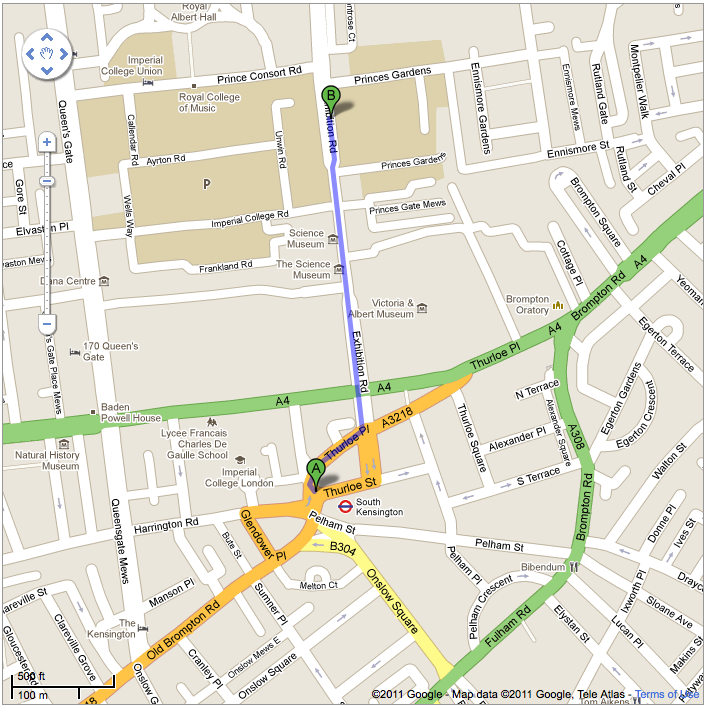Next Meeting
The next meeting will be on
Wednesday 23rd March 2011 in the
Seminar Room, 53 Princes Gate, Imperial College London. It is completely free to attend.
Please get in touch with either
Matty Hoban or
Peter Lewis if you are planning on attending. Please let us know as soon as possible so as we have an idea about numbers expected.
Here is a map:
 "InAs/GaAs quantum dots: how do they grow and what do they do?"Peter Spencer (Imperial College London)
"InAs/GaAs quantum dots: how do they grow and what do they do?"Peter Spencer (Imperial College London)In order to realise devices and experiments that make use of quantum coherence effects requires a close to ideal system; such a system would be one where quantum states can be prepared, transported , interact and read-out. There are many such candidate systems and among them is semiconductor quantum dots (QDs) grown by molecular beam epitaxy (MBE) and based on nanoscale inclusions of indium arsenide (InAs) within a gallium arsenide (GaAs) host crystal matrix. The lower bandgap of InAs compared with GaAs gives rise to three-dimensional confinement of electrons and holes in the QDs in an analogous way to atomic systems, leading them to be sometimes referred to as "artificial atoms".
The fabrication of high-quality three dimensional structures is a challenging task; however we are helped by nature in this regard. The crystal lattice constant is related to the bandgap of the material, causing a strain to develop when InAs is grown on GaAs. Careful control of the growth conditions allows this strain to self-assemble the QDs by the Stranski-Krastanow process. The resulting QDs, already built-into workable semiconductor devices, exhibit optical transitions between wavelengths of approximately 1 microns and 1.3 to 1.5 microns where telecommunications' optics are based.
In our work we grow QD material and investigate their properties, with a particular interest in the spin degree of freedom. We are working on a practical demonstration of spin state preparation, transport and read-out within a bi-layer arrangement (sometimes called a QD molecule). In this talk I will give an overview of how we grow these samples, their basic properties together with an overview of interesting results from our group and the others in this field.
"Phonon-Induced Damping of Exciton Rabi Rotations in Optically Excited Quantum Dots"Ahsan Nazir (Imperial College London)In this talk, I shall explore the interplay of quantum
coherence and decoherence in quantum dot exciton dynamics.
Specifically, I shall describe recent theoretical work demonstrating
that the dephasing observed experimentally in single,
coherently-driven InGaAs/GaAs quantum dots can be accurately described
within a simple weak-coupling master equation formalism [1,2],
identifying acoustic-phonons as the dominant source of excitonic
decoherence.
[1] A. J. Ramsay et al., Phys. Rev. Lett. 104, 017402 (2010)
[2] A. J. Ramsay et al., Phys. Rev. Lett. 105, 177402 (2010)
"Quantum Information Processing with nuclear-electronic spin systems"Hamed Mohammady (UCL)"Bell inequalities and Computation" (15 minute)Matty Hoban (UCL)"Bell inequalities sans Computation" (15 minute)Matthew Pusey (Imperial College London)"A top-down approach to Mutually Unbiased Bases"Gary McConnell (Imperial College London)"Continuous-variable Cluster States"Dan Browne (UCL)

